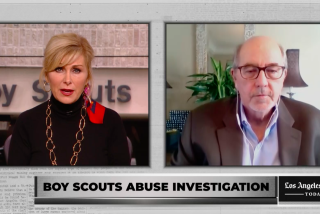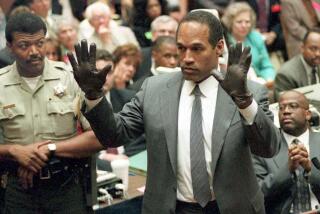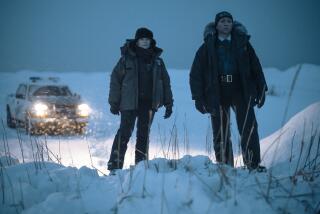Keith Morrison on his true-crime beat: ‘I sort of had to be dragged into the murder business’
With so many murders to cover on the airwaves, it is a busy time for the king of true-life crime, Keith Morrison.
This month alone, Morrison hosted an Investigation Discovery Channel special that challenged facts in Netflix’s documentary series “Making a Murderer” (the latter exculpates convicted murderer Steve Avery) and launched a four-part examination of wrongful convictions, “In the Shadow of Justice,” on the popular NBC news magazine “Dateline.”
See more of Entertainment’s top stories on Facebook >>
The 6-foot-2, gaunt and copiously white-haired “Dateline” correspondent has been reporting for nearly 40 years, and he has seen and done just about everything — from hosting a morning show to anchoring the news to covering the protests in Tiananmen Square. But for all that, the 69-year-old is not only busier than ever (“Dateline” filled 150 hours on NBC last year), he’s also suddenly achieved a kind of rock star cult status.
Correspondents don’t typically have fans. Morrison has scads of them, including Lady Gaga, Jessica Alba and Lindsay Lohan. Correspondents don’t typically invite impersonations either, but Morrison has had plenty, most famously Bill Hader on “Saturday Night Live.” And no other correspondent has prompted Buzzfeed to post 19 reasons why he is “Television’s Greatest Gift to Mankind” as it did about Morrison. But then there has never been a reporter quite like Keith Morrison.
Morrison, who delivers his reports in a deep and expressive baritone that soars and dips and writes them with a distinctive turn of phrase (“Outside, the night, in a full moon, bathed the great houses of delight and sin...” or “There is a letter, written more than 60 years ago — a prophecy? Perhaps. A warning? Certainly.”), is what in music would be called a crossover artist. He is a serious journalist who has transitioned into the role of “star” in the genre of news entertainment, primarily those crime stories.
Ah, crime! as Morrison might say. “Dateline” debuted in March 1992, covering such diverse topics as investigations of consumer products and the whales who starred in the film “Free Willy.” But the show’s senior executive producer, David Corvo, says that once crime stories began to appear, they “really connected,” which led in 2005 to the metamorphosis of the show into two-hour-long, real-life murder mysteries. And that led to Morrison’s ascent.
Morrison doesn’t find the stories; producers usually do. And Morrison doesn’t write the first drafts of the scripts; producers do that too. What Morrison does is provide the brand. He describes himself modestly as a “rewrite man” — modest because once he takes his pass on the material, the words are inimitably his.
Producer Robert Dean calls him a “master storyteller”: “He has a way of taking a story and diving into all the layers and nuances of it and organizing it into a compelling narrative.”
And if he has a distinctive way of writing lines and delivering them, he has an equally distinctive series of tics: the arched brows signaling incredulity, the skeptically cocked head, the wince at something that doesn’t quite compute. He says he learned a long time ago that “your face tells a story,” and you need “some sort of internal reaction to what you’re telling people or otherwise it won’t get through to them.”
But if you really want to understand Morrison’s newfound popularity, you have to look at something else too: his attitude, which is an exquisite balance of seriousness and self-parody, of the empathetic and the macabre, of a news reporter and Vincent Price.
Morrison admits he had misgivings in moving from straight reporting to reporting mysteries. “I sort of had to be dragged into the murder business,” he says. “It just didn’t seem right somehow. We were taking these intensely affecting, deeply personal incidents in people’s lives and making entertainment from them.” But he also recognized that this was a tide that could not be turned.
Morrison was born in Canada in the small farming and oil town of Lloydminster on the Saskatchewan-Alberta border. His father, a minister, was a master storyteller, and his mother a music teacher who was “constantly drumming into us the importance of cadence.”
Morrison thought he might use those inherited skills to become a lawyer, but a self-professed “terrible student,” he dropped out of the University of Saskatchewan, landed a job at a local radio station as a reporter, and never went back to college. Thus began his itinerant career in radio and then television — from small stations in Saskatoon and Regina to Toronto.
He rose rapidly in Canadian television, so much so that in 1985, KNBC brought him in to anchor its 5 p.m. and 11 p.m. broadcasts. Later, he began doing pieces for the network. He and his wife, Susan, whom he met when she was Canadian politician Pierre Trudeau’s press secretary (and who is the mother of television star Matthew Perry), had thought of his American venture as a sabbatical. So he returned to Canada, where he was to be groomed to inherit the anchor chair from that country’s version of Walter Cronkite, Lloyd Robertson. But Morrison was summarily fired when Robertson decided not to retire, so that same day he phoned NBC and was assigned a story about a female auto mechanic in Pittsburgh. The venue was “Dateline.”
Morrison lost the anchor chair he coveted, but he gained the opportunity on “Dateline” to get inside the people he interviews. Morrison’s gift as an interviewer is that he makes his subjects comfortable enough that they want to tell him their story. Dean cites the story of a woman who was brutally assaulted and then burned by her assailant and who was reluctant to talk about her ordeal. “So Keith sat down, and the magic just started rolling. Keith drew her out, and she did this very emotional, very inspiring interview that had all of us practically in tears, including Keith. I get chills just thinking about it.”
Ask Morrison if he worries that he is exploiting vulnerable individuals, and he will admit he does. But then he recalls a “big surprise” early in his career in Saskatoon when he was ordered to get a “pick up” for a story about a crossing guard who had been hit by a car and killed. He pulled up to the widow’s house just hours after her loss, feeling “like the worst person in the world” and asked her for a picture of her late husband. And she invited him in, gave him tea and biscuits, and talked for a long time — which is when Morrison said he realized people want to get their story out. You don’t exploit victims. You facilitate their agenda.
Even so, there are traditionalists who believe the entire enterprise of real-life mysteries is a deleterious one. Morrison disagrees. He thinks the program has real value in examining the weaknesses of the American justice system. In at least one case, that of Barry Beach, who spent 32 years in a Montana prison after being falsely convicted of murder, “Dateline” and Morrison not only found the real killers but also helped pressure the system into releasing Beach.
The folks who produce “Dateline” believe there may be another function for the show: to examine the human condition. “It’s about characters and what happened to them that led to some crisis,” Corvo says. “What disappointment. What failure. What betrayal.” Producer Dean puts it a bit differently. He says audiences are fascinated by the thin line that separates ordinary behavior from behavior outside the boundaries, which means that the perpetrators are seldom monsters. They are us.
That makes Morrison the Dostoevsky of the genre too. He confesses that dealing with the worst of human behavior week in and week out (he is on the road more than 40 weeks each year) might sour him. “But then you get involved in the details,” he says, “and you talk to the people involved, and you hear what the real issues are behind these stories, it’s so interesting that you can’t possibly stay away from it.”
More to Read
The complete guide to home viewing
Get Screen Gab for everything about the TV shows and streaming movies everyone’s talking about.
You may occasionally receive promotional content from the Los Angeles Times.






